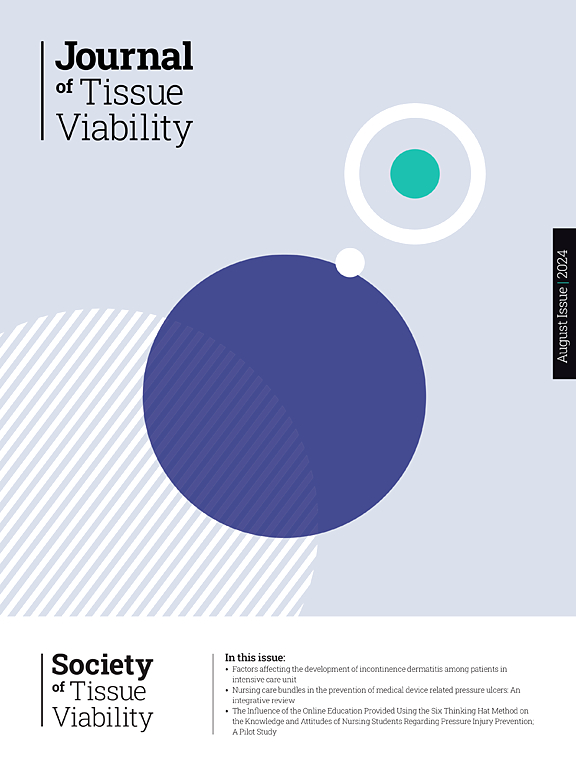了解复发性压力损伤:当前研究和危险因素的范围综述
IF 2.4
3区 医学
Q2 DERMATOLOGY
引用次数: 0
摘要
目的描述已发表的关于复发性压力损伤现状的研究。背景压力损伤给患者和医疗保健系统造成了负担,因此必须防止其复发并防止患者遭受二次损伤。然而,目前大多数研究都侧重于原发性压力损伤,而较少关注其复发情况。从数据库建立到 2024 年 12 月 9 日,我们检索了 PubMed、Embase、Web of Science、CINAHL 和 Cochrane 图书馆。结果有 28 篇文章符合我们的标准,其中大部分发表于 2000 年之后。纳入的研究显示,13 篇文章涉及了复发性压力损伤的定义,但尚未形成统一的标准。复发性压力损伤的发生率为 5.4 %-73.6 %。最常报道的复发部位是骶骨。脊髓损伤患者是复发的高危人群。有 11 项研究描述了 26 个导致压力损伤复发的风险因素,其中白蛋白是最常见的风险因素,其次是脊髓损伤、年龄、住院时间和溃疡大小。这 26 个风险因素被归纳为五个方面:个人因素、社会环境因素、疾病相关因素、生理生化参数和初始溃疡特征。结论复发性压力损伤的发病率差异很大,必须进一步确定具体定义和标准化分期标准,以提高临床判断和报告的准确性。复发性压力损伤的风险因素涉及多个方面。一些研究将局部皮瓣和整体复发风险因素分开描述,需要进一步验证以确定两者之间是否存在差异。本文章由计算机程序翻译,如有差异,请以英文原文为准。
Understanding recurrent pressure injuries: A scoping review of current research and risk factors
Aim
To describe published studies on the current status of recurrent pressure injuries.
Background
Pressure injuries burden patients and the health care system, so it is essential to prevent their recurrence and prevent patients from experiencing secondary injury. However, most current studies focus on primary pressure injury and less on its recurrence.
Design and methods
We employed a scoping review methodology. From the database construction until December 9, 2024, we searched PubMed, Embase, Web of Science, CINAHL, and the Cochrane Library. Two researchers independently screened and extracted data.
Results
Twenty-eight articles met our criteria, most published after 2000. The included studies showed that 13 articles dealt with the definition of recurrent pressure injuries, but no uniform standard has been formed yet. The incidence of recurrent pressure injuries is 5.4 %–73.6 %. The most commonly reported site of recurrence is the ischium. The high-risk population for recurrence is the patient with spinal cord injury. Eleven studies described 26 risk factors for recurrent pressure injuries, of which albumin was the most commonly reported risk factor, followed by spinal cord injuries, age, hospital stay, and ulcer size. The 26 risk factors were summarised into five aspects: personal factors, social-environmental factors, disease-related factors, physiological and biochemical parameters, and Initial ulcer characteristics.
Conclusions
The incidence of recurrent pressure injuries varies widely, and specific definitions and standardised staging criteria must be further determined to improve clinical judgment and reporting accuracy. The risk factors for recurrent pressure injuries involve many aspects. Some studies have described local flaps and overall recurrence risk factors separately, and further verification is needed to determine whether there is a difference between the two.
求助全文
通过发布文献求助,成功后即可免费获取论文全文。
去求助
来源期刊

Journal of tissue viability
DERMATOLOGY-NURSING
CiteScore
3.80
自引率
16.00%
发文量
110
审稿时长
>12 weeks
期刊介绍:
The Journal of Tissue Viability is the official publication of the Tissue Viability Society and is a quarterly journal concerned with all aspects of the occurrence and treatment of wounds, ulcers and pressure sores including patient care, pain, nutrition, wound healing, research, prevention, mobility, social problems and management.
The Journal particularly encourages papers covering skin and skin wounds but will consider articles that discuss injury in any tissue. Articles that stress the multi-professional nature of tissue viability are especially welcome. We seek to encourage new authors as well as well-established contributors to the field - one aim of the journal is to enable all participants in tissue viability to share information with colleagues.
 求助内容:
求助内容: 应助结果提醒方式:
应助结果提醒方式:


